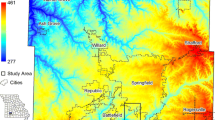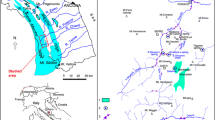Abstract
Dye-tracing methods are utilized in an area of southwestern Missouri, USA, in order to evaluate factors influencing groundwater flow in the karst lithology. Four new dye traces were conducted in the Burlington Limestone formation of the surficial Springfield Plateau aquifer. Dye traces were conducted with two large sinkholes with mapped caves as their drainage base, one with fluorescein and one with rhodamine-WT. Two other traces, both using fluorescein dye, were performed where dye was introduced into a groundwater-level monitoring well and an exploratory borehole. Results of these four traces indicate that structural geologic control—as expressed by joints, fractures, faults, and photolineaments—does not account solely for the observed dye-trace results. The available data suggest that significant influence on groundwater movement is exerted by bedding planes within the low dip-angle limestone formation or by lithologic variability within the formation (such as silt- or clay-rich layers that have not yet been clearly identified). Average linear tracer velocities from each of the four traces indicate groundwater movement is primarily through conduits that flow slower than open channel surface waters in the region, but significantly faster than typical groundwater flow through porous media.
Résumé
La méthode de traçage fluorescent a été utilisée dans un secteur du sud-ouest du Missouri, Etats-Unis, afin d’évaluer les facteurs influençant les flux d’eau souterraine dans les formations karstiques. Quatre nouveaux traçages ont été effectués dans les formations calcaires de Burlington de l’aquifère superficiel du plateau de Springfield. Les traçages ont été menés à partir de deux importantes dolines ayant des cavités cartographiées à leur base, un avec de la fluorescéine et une autre avec de la rhodamine-WT. Deux autres traçages, tous deux à la fluorescéine, ont été réalisés avec introduction du traceur dans un piézomètre et un forage d’exploration. Les résultats des quatre traçages indiquent que le contrôle géologique structural, exprimé par les joints, fractures, failles et photo-linéaments n’est pas l’unique paramètre permettant d’expliquer les résultats des traceurs. Les données disponibles indiquent qu’une influence significative sur le mouvement de l’eau souterraine est exercée par les plans de stratification au sein de la formation calcaire possédant un faible angle de pendage ou par la variabilité lithologique de la formation (comme des couches plus riches en argiles ou limons qui n’ont pas encore été clairement identifiées). Les vitesses linéaires moyennes de chacun des traceurs indiquent que le mouvement de l’eau souterraine se fait principalement au travers des conduits et de manière plus lente que dans des chenaux ouverts d’eau de surface de la région mais de manière plus rapide que le flux souterrain typique du milieu poreux.
Resumen
Se utilizaron métodos de trazadores colorantes en un área del sudoeste de Missouri, EEUU, con el objeto de evaluar los factores influyentes en el flujo de aguas subterráneas en la litología de karst. Cuatro nuevos trazadores colorantes fueron inyectados en la formación de caliza Burlington del acuífero superficial de Springfield Plateau. Los trazadores colorantes fueron inyectados con 2 grandes sumideros con cavernas mapeadas como base de drenaje., uno con fluoresceína, y otro con rodamina-WT. Se realizaron otras dos trazas, en ambos casos utilizando como colorante la fluoresceína, donde el colorante fue introducido en un pozo de monitoreo del nivel de agua subterránea y en un pozo exploratorio. Los resultados de estas cuatro trazas indican que el control geológico estructural—expresados por diaclasas, fracturas, fallas y fotolineamientos—no explican solamente los resultados observados de lso trazadores colorantes. Los datos disponibles sugieren que una influencia significativa en el movimiento de aguas subterráneas es ejercida por planos de capas de bajo ángulo de inclinación de la formación de caliza o por la variabilidad litológica dentro de la formación (tales como capas ricas en limo o arcilla que todavía no han sido claramente identificadas). Las velocidades lineales promedio de los trazadores de cada una de las cuatro trazas indican que el movimiento del agua subterránea se produce básicamente a través de conductos cuyo flujo es más lento que el agua superficial de canales abiertos en la región, pero significativamente más rápido que el flujo típico de agua subterránea a través de un medio poroso.
摘要
利用染色示踪方法评估美国密苏里州西南部喀斯特地区地下水流的影响因素。在斯普林菲尔德高原浅部含水层伯林顿灰岩地层开展了四次染色示踪试验。将荧光素和若丹明-WT分别投入以溶洞为排泄出路的两个落水洞。另外两次荧光素示踪试验在地下水水位监测井和勘查孔进行。结果显示地质构造 (如节理、破裂、断层和面理等) 控制理论不能完全解释示踪剂的运移规律。现有数据显示地下水运动主要由低倾角灰岩地层层面或地层岩性差异控制 (或许是含粉土或粘土富集的地层)。 四次示踪得出的平均线速度都显示地下水主要通过管道流动, 其流速小于地表明渠, 但是显著大于典型的孔隙流。
Resumo
Numa área do sudoeste do Missouri, EUA, utilizam-se ensaios com traçadores fluorescentes, a fim de avaliar os factores que influenciam o escoamento das águas subterrâneas na litologia cársica. Foram realizados quatro novos ensaios de traçadores na formação Calcária de Burlington, no aquífero superficial do Planalto de Springfield. Os ensaios foram realizados em duas grandes dolinas com cavernas mapeadas, como a sua base de drenagem, um usando Fluoresceína e outro usando Rodamina-WT. Efectuaram-se ainda dois outros ensaios, ambos com Fluoresceína, onde o traçador foi introduzido num furo de monitorização de nível piezométrico e num poço exploratório. Os resultados destes quatro ensaios indicam que a sua interpretação não pode ser atribuída unicamente ao controlo geológico-estrutural, expresso por diaclases, fracturas, falhas e alinhamentos fotointerpretados. Os dados disponíveis sugerem que o movimento das águas subterrâneas é fortemente influenciado pelos planos de estratificação pouco inclinados existentes dentro da formação calcária ou pela variabilidade litológica dentro da formação (como camadas ricas em silte ou argila que ainda não foram claramente identificadas). As velocidades lineares médias obtidas em cada um dos quatro ensaios de traçadores indicam que o escoamento das águas subterrâneas ocorre principalmente através de condutas cujo fluxo é mais lento do que o escoamento superficial em canais abertos da região, mas significativamente mais rápido do que o fluxo característico de meios porosos.






Similar content being viewed by others
References
Aley T, Thomson KC (1981) Hydrogeologic mapping of unincorporated Green County, Missouri, to identify areas where sinkhole flooding and serious groundwater contamination could result from land development: project summary prepared for Green County Sewer District by Ozark Underground Laboratory, Protem, MO, under contract with Missouri Department of Natural Resources, Jefferson City, MO
Brahana JV (1997) Rationale and methodology for approximating spring-basin boundaries in the mantled karst terrane of the Springfield Plateau, northwestern Arkansas. In: Beck BF, Stephenson JB (eds) The engineering geology and hydrogeology of karst terranes. Balkema, Rotterdam, The Netherlands, pp 77–82
Bullard L, Thomson KC, Vandike JE (2001) The springs of Greene County Missouri. Water Resources Report No. 68, Missouri Department of Natural Resources, Jefferson City, MO, 120 pp
Emmett LF, Skelton J, Luckey RR, Miller DE, Thompson TL, Whitfield JW (1978) Water resources and geology of the Springfield Area, Mo. Water Resources Report No. 34, Missouri Department of Natural Resources, Jefferson City, MO, 150 pp
Ford DC, Williams P (2007) Karst hydrogeology and geomorphology. Wiley, Chichester, UK, 562 pp
Gillieson DS (1996) Caves: processes, development, and management. Blackwell, Oxford, 324 pp
Greene EA (1999) Characterizing recharge to wells in carbonate aquifers using environmental and artificial tracers. Proceedings of the Technical Meeting, Toxic Substances Hydrology Program, Charleston, SC, 8 March 1999. US Geol Surv Water Resour Invest Rep 99-4018C
Harvey EJ, Skelton J (1968) Hydrologic study of a waste-disposal problem in a Karst Area at Springfield, Missouri. US Geol Surv Prof Pap 600-C, pp C217–C220
Imes JL (1989) Compilation of geohydrologic data collected as part of the areal appraisal of ground-water resources near Branson, Missouri. US Geol Surv Open-File Rep 89–401
MDNR (Missouri Department of Natural Resources) (2007) Missouri environmental geology atlas, MDNR, Jefferson City, MO
NOAA (National Oceanic and Atmospheric Administration) (2007) Local preliminary climatological data report. National Weather Service Forecast Office, Springfield, MO. http://www.weather.gov/climate/index.php?wfo=sgf. Cited 21 December 2009
Nguyet VT, Batelaan O, Smedt FD (2002) Contribution to the karst hydrogeology of Son LA, Vietnam by artificial tracer experiments. Proceedings of the International Conference on Development and Conservation of Karst Regions, Hanoi, Vietnam, 13–18 September 2004
Smart CC, Karunaratne KC (2002) Characterisation of fluorescence background in dye tracing. Environ Geol 42:492–498
Stohr CJ, Ivany G, Williams JH (1981) Geologic aspects of hazardous waste isolation in Missouri. Engineering geology report No. 6, MDNR, Jefferson City, MO, 55 pp
Taylor CJ, Greene EA (2001) Quantitative approaches in characterizing Karst Aquifers. US Geological Survey Karst Interest Group Proceedings, US Geol Surv Water Resour Invest Rep 01-4011, pp 164–166
Thomson KC (1997) Field trip through the karst areas of southern Greene and northern Christian counties, Missouri, emphasizing the relationships between surface features and springs. In: Beck BF, Stephenson JB (eds) The engineering geology and hydrogeology of karst terranes. Balkema, Rotterdam, The Netherlands, pp 479–505
United States Census Bureau (2006) Quick guide to the 2005 American community survey products. http://factfinder.census.gov/home/saff/aff_acs2005_quickguide.pdf. Cited 21 December 2009
Vandike JE, Shennan D (1994) Hydrogeologic investigation of the Fulbright Area, Greene County, Missouri. Water resources report, No. 43, MDNR, Jefferson City, MO
Waite LA, Thomson KC (1993) Development, description, and application of a geographic information system data base for water resources in karst terrane in Greene County, Missouri. US Geol Surv Open-File Rep 93-4154, 31 pp
White WB (2002) Karst hydrology: recent developments and open questions. Eng Geol 65:85–105
Acknowledgements
The authors wish to acknowledge the kind cooperation of numerous landowners in the study region, especially M. Nau, R. Campbell, Rev. and Mrs. Snavely, D. Jones, D. Holberg, and Springfield Underground, Inc. for their assistance in this investigation. Finally, the authors wish to thank S-S. ‘Derek’ Wu and B. Stanke for their assistance in improving the figures and two anonymous reviewers for helpful comments which significantly improved the manuscript.
Author information
Authors and Affiliations
Corresponding author
Rights and permissions
About this article
Cite this article
Gouzie, D., Dodd, R.P. & White, D.M. Dye-tracing studies in southwestern Missouri, USA: indication of stratigraphic flow control in the Burlington Limestone. Hydrogeol J 18, 1043–1052 (2010). https://doi.org/10.1007/s10040-010-0581-5
Received:
Accepted:
Published:
Issue Date:
DOI: https://doi.org/10.1007/s10040-010-0581-5




